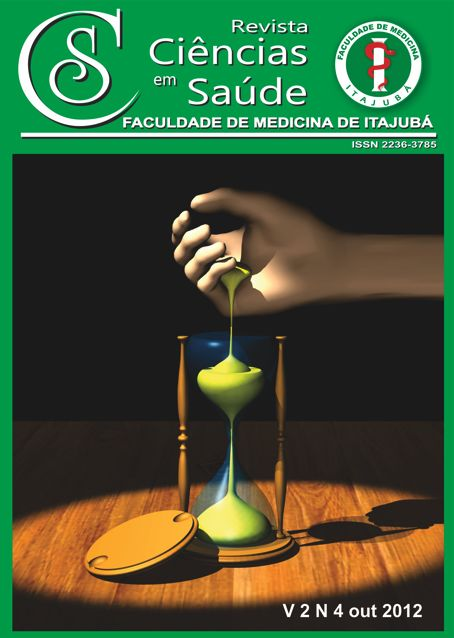Efeito do Halotano sobre a Gestação e a Viabilidade Embrionária em Ratos - Estudo Experimental/Effect of Halothane on Pregnancy and Embryonic Viability in Rats - Experimental Study
Main Article Content
Abstract
Objetivo: conhecer alterações morfológicas no desenvolvimento embrionário de filhotes de ratas expostas ao halotano no período estral e gestacional e avaliar o período gestacional de maior risco. Materiais e Métodos: projeto aprovado pela Comissão de Ética e Pesquisa da UNIFENAS (Parecer Nº 11ª/2008). Foram utilizadas 25 ratas da linhagem Wistar distribuídas em cinco grupos. Grupo 1: controle (n=5) ratas com prenhez identificada sem exposição ao halotano. Grupo 2: (n=5) ratas expostas ao halotano no período estral. Grupos 3: (n=5) ratas expostas ao halotano no 8º-10º dia de prenhez. Grupo 4: (n=5) ratas expostas ao halotano no 11º a 13º dia e Grupo 5:(n=5) 14º a 16º dia. Os animais foram expostos ao halotano (0,8%) por 30 minutos com oxigênio a 100%. Os filhotes, analisados quanto ao tamanho, peso, alterações morfológicas e comprimento do cordão umbilical e número de nascidos vivos por grupo. Os resultados foram expressos como média (+-), desvio padrão da média, seguida de teste de Tukey. Resultados: Ocorreram alterações morfológicas no período gestacional e alterações no peso, tamanho e comprimento do cordão umbilical de filhotes do grupo 2 (3,05 ± 0,10 cm, 3,17 ± 0,17g e 2,57 ± 0,12 cm), sendo significativo (p<0,005). Conclusão: Halotano não comprometeu a fertilização dos animais estudados, mas promoveu o aparecimento de alterações morfológicas no primeiro período gestacional, mostrando o risco de teratogenicidade e consequentemente, a inviabilidade embrionária.
Palavras chave: halotano, gestação, ratos
ABSTRACT
Objective: identify morphological changes in embryonic development in rats exposed to gestational and halotano estrous period and assess the gestational period of greatest risk. Material and Methods: project approved by Commission standards and research ethics at UNIFENAS (Federal University of Alfenas) (Opinion No. 11ª /2008). We used 25 female Wistar rats, distributed in five groups. Group 1: control (n=5) rats with pregnancy identified without exposure to halothane. Group 2: (n=5) rats exposed to halothane during estrous period. Groups 3: (n=5) rats exposed to halothane in 8th to 10th day of pregnancy. Group 4: (n=5) rats exposed to halothane in 11th to 13th days of pregnancy, and Group 5: (n=5) 14th to 16th days. The animals were exposed to halothane (0.8%) for 30 minutes with 100% oxygen. The offspring of the groups was analyzed according to size, weight, morphological and umbilical cord length and number of live births in each group. Results were expressed as mean +- standard deviation, followed by Tukey test. Results: morphological changes in different periods of pregnancy and changes in weight, size and length of the cord in group 2 (3.05±0.10 cm, 3.17±0.17 g and 2.57±0.12 cm) being significant (p<0.005). Conclusion: halothane did not affect the fertility of the animals studied, but promoted the appearance of morphological changes in the first period of pregnancy, showing the risk of teratogenicity and therefore the embryonic infeasibility.
Key words: halothane, pregnancy, rats
Article Details
Authors maintain copyright and grant the HSJ the right to first publication. From 2024, the publications wiil be licensed under Attribution 4.0 International 
 , allowing their sharing, recognizing the authorship and initial publication in this journal.
, allowing their sharing, recognizing the authorship and initial publication in this journal.
Authors are authorized to assume additional contracts separately for the non-exclusive distribution of the version of the work published in this journal (e.g., publishing in an institutional repository or as a book chapter), with acknowledgment of authorship and initial publication in this journal.
Authors are encouraged to publish and distribute their work online (e.g., in institutional repositories or on their personal page) at any point after the editorial process.
Also, the AUTHOR is informed and consents that the HSJ can incorporate his article into existing or future scientific databases and indexers, under the conditions defined by the latter at all times, which will involve, at least, the possibility that the holders of these databases can perform the following actions on the article.

